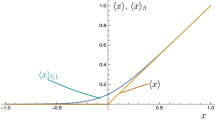Abstract
The paper illustrates the application of a general two-step integration scheme for the rate plasticity equations to the case of Drucker-Prager's model with linear mixed hardening and associated flow rule. The integration scheme coincides, for the case of the Mises equations, with a ‘tangent predictor-radial return’ method with automatic sub-incrementation, the sub-increment size being governed by a predefined tolerance on the value of the yield stress. However, in contrast with the integration methods commonly adopted in several codes, the return step is here based on a precisely formulated rate problem, and it is not necessarily a radial one, in general. Thus, the accuracy characteristics of the method should carry over to every constitutive model tackled, depending only on the choice of the tolerance parameter value. The application of the integration scheme to Drucker-Prager's equations shows that the accuracy is in fact comparable to that obtained in the Mises case, for similar values of the tolerance parameter; at the same time some peculiarities of Drucker-Prager's yield condition, most notably the presence of a singular point in the stress space, highlight the flexibility and generality of the proposed method. Its theoretical basis, in fact, holds for vector-valued yield functions, thus automatically incorporating the treatment of the cases in which the stress points reach a corner in the yield surface.
Sommario
Il lavoro illustra l'applicazione di uno schema di integrazione a due passi delle equazioni della plasticità incrementale al caso del modello di Drucker-Prager con incrudimento lineare misto e legge di scorrimento associata. Lo schema di integrazione si riduce, per il modello di Von Mises, a un metodo ‘tangent predictor-radial return’ con subincrementazione automatica. L'ampiezza dei subincrementi è governata da una tolleranza prefissata sul valore dello sforzo di snervamento. A differenza dei metodi di integrazione comunemente impiegati in diversi codici di calcolo, il passo di ritorno qui è basato su un problema incrementale ben formulato, e non è necessariamente un passo radiale, in generale. In questo modo le caratteristiche di accuratezza del metodo non dovrebbero dipendere dalla legge costitutiva adottata, ma solo dal valore scelto della tolleranza. In effetti, l'applicazione del metodo alle equazioni di Drucker-Prager mostra che l'accuratezza ottenibile è paragonabile a quella ottenuta per il caso di Von Mises. Allo stesso tempo alcune caratteristiche della condizione di Drucker-Prager, in particolare la presenza di un punto singolare nello spazio degli sforzi, evidenziano la flessibilità e la generalità di applicazione del metodo studiato. Esso infatti ha basi teoriche valide anche per superfici di snervamento vettoriali, che incorporano perciò automaticamente il trattamento dei casi in cui lo sforzo si trova in punti angolosi.
Similar content being viewed by others
References
Franchi, A. and Genna, F., ‘A numerical scheme for integrating the rate plasticity equations with an‘a priori’ error control’,Comp. Meth. Appl. Mech. Engrg.,60 (1987) 317–342.
Franchi, A. and Genna, F., ‘A stable/neutral equilibrium path for the numerical solution of elastic-plastic softening problems’,Comp. Meth. Appl. Mech. Engrg.,90 (1991) 921–942.
Franchi, A., Genna, F. and Riva, P., ‘Incremental elastic-Ziegler kinematic hardening plasticity formulations and an algorithm for the numerical integration with ana priori error control’,Progress in Structural Engineering, D. Grierson, A. Franchi and P. Riva, (eds),Solid Mechanics and its Applications, Vol. 10, Kluwer, (1991) pp. 407–421.
Genna, F., ‘Integration of plasticity equations for the case of Ziegler's kinematic hardening’,Comp. Meth. Appl. Mech. Engrg.,109 (1993) 111–130.
Maier, G., ‘Linear flow-laws of elastoplasticity: a unified general approach’,Rend. Accad. Naz. Lincei,48 (8) (1969) 266–276.
Loret, B. and Prevost, J. H., ‘Accurate numerical solutions for Drucker-Prager elastic-plastic models’,Comp. Meth. Appl. Mech. Engrg.,54 (1986) 259–277.
Krieg, R. D. and Krieg, D. B., ‘Accuracies of Numerical Solution Methods for the Elastic-Perfectly Plastic Model’,Transactions of the ASME,99(4) (1977) 510–515.
ABAQUS Theoretical and Example Problems Manual, Release 5.2, Hibbitt, Karlsson & Sorensen, Inc., Providence, RI, (1992).
Loret, B., Hammoum, F. and Dafalias, Y. F., ‘A note on the accuracy of stress-point algorithms for anisotropic elastic-plastic solids’,Comp. Meth. Appl. Mech. Engrg.,98 (1992) 399–409.
Perego, U., ‘Explicit backward difference operators and consistent predictors for linear hardening elasticplastic constitutive laws’,SM Archives,13/2 (1988) 65–102.
Genna, F., ‘A nonlinear inequality, finite element approach to the direct computation of shakedown load safety factors’,Int. J. Mech. Sci.,30 (1988) 769–789.
Author information
Authors and Affiliations
Rights and permissions
About this article
Cite this article
Genna, F., Pandolfi, A. Accurate numerical integration of Drucker-Prager's constitutive equations. Meccanica 29, 239–260 (1994). https://doi.org/10.1007/BF01461438
Received:
Accepted:
Issue Date:
DOI: https://doi.org/10.1007/BF01461438




